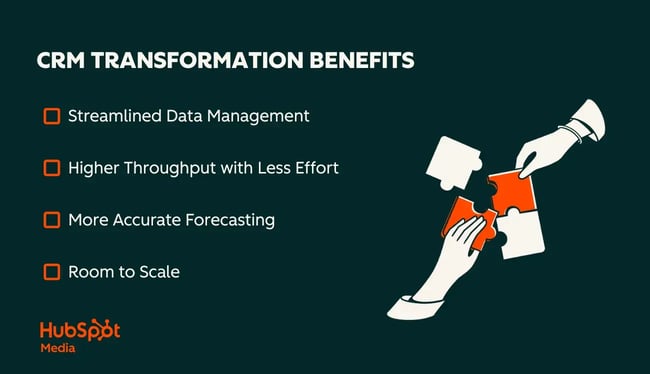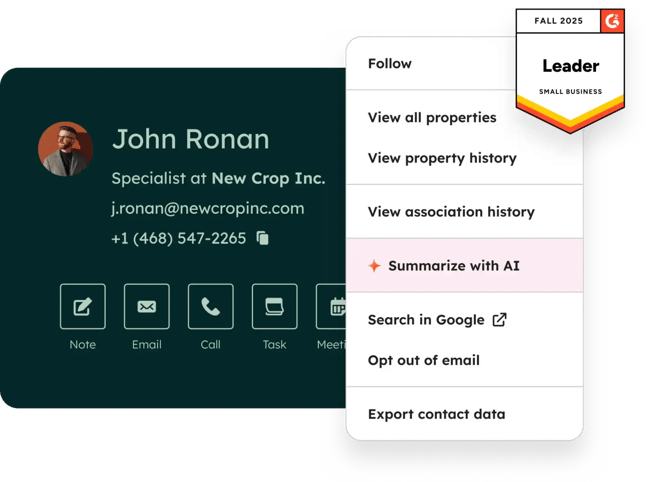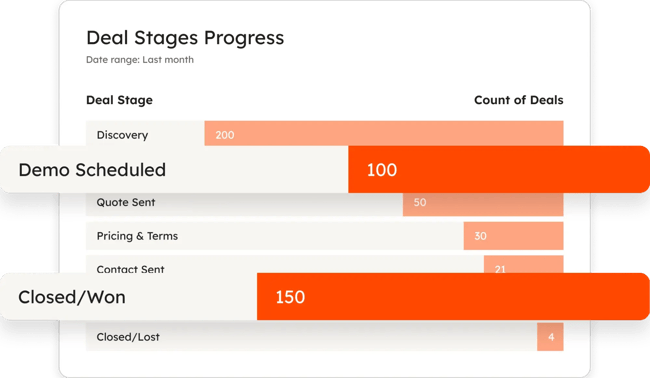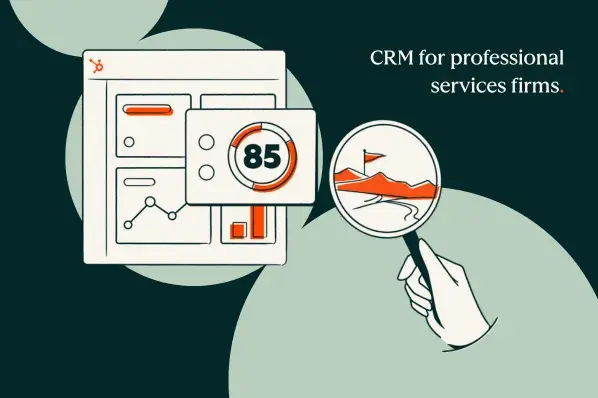Especially in the age of AI, professional services firms are in the business of relationships. People work with people, and once a certain bar of expertise is met, closing sales requires trust and a deep understanding of the people on the other side of the table.
 Despite this need, many organizations still rely on spreadsheets and manual systems to manage sales. What starts as a simple and cost-effective minimum viable product (MVP) can eventually balloon into excess manual processes and hidden inefficiencies. This results in missed follow-ups, inaccurate forecasting, and a lack of visibility into pipeline health.
Despite this need, many organizations still rely on spreadsheets and manual systems to manage sales. What starts as a simple and cost-effective minimum viable product (MVP) can eventually balloon into excess manual processes and hidden inefficiencies. This results in missed follow-ups, inaccurate forecasting, and a lack of visibility into pipeline health.
As firms grow, what worked in the early days becomes a roadblock. The result is slower sales cycles. That’s where a CRM with an automated sales pipeline comes in. Like a spreadsheet, the right CRM digitizes recordkeeping. However, CRMs also provide a foundation for scalability by giving sales leaders the data and automation they need to close deals faster.
Table of Contents
- Manual processes kill revenue.
- Benefits of CRM Transformation: The Power of Automation
- Case Study: How a CRM Helped Sandler Scale Its Sales
- CRM Features for Your Professional Services Business
- The Complete Playbook for Transitioning to a CRM
- The Sales Pipeline Automation Migration Checklist
- Tips for Managing the Transition to a CRM
- Q&A
Manual processes kill revenue.
Plenty of professional services firms lose deals simply because their systems can’t keep up. When account executives are juggling spreadsheets, sticky notes, and email threads, things inevitably fall through the cracks.
I’ve seen it all. A prospect might not get a follow-up at the right time. A renewal reminder gets buried. Or in the most cringe-inducing cases, multiple team members pitch the same prospect or even an existing customer without realizing it.
The biggest issue is visibility. Leadership can’t get a clear picture of the pipeline from dozens of disconnected documents, which makes forecasting nearly impossible. Teams end up flying blind, with no knowledge of which opportunities are pressing, which are stalled, and where they should focus limited resources.
Manual processes also create a culture of reaction instead of proactivity. Reps are stuck logging activity, pulling them away from relationship-building. Managers spend more time cleaning data than coaching teams. In today’s competitive services landscape, that inefficiency translates directly into lost revenue.
Benefits of CRM Transformation: The Power of Automation
CRMs can help teams:
- Streamline data management.
- Achieve higher throughput with less effort.
- Forecast more accurately.
- And scale.
If you’re reading this article, you’ve hopefully already bought into the power of CRMs to transform your sales pipeline. Just to be sure, here are just a few of the most common benefits I’ve seen a well-configured CRM deliver.

Streamlined Data Management
With a well-organized CRM, every client touchpoint lives in one system. No more toggling between spreadsheets, email, and project notes. CRMs can ensure communication data is automatically logged into a single source of truth, so sales reps can see the full client history before every call. This reduces admin work and improves accuracy across the team.
Higher Throughput with Less Effort
The difference between deals won and lost comes down to timing. With a little setup ahead of time, automated workflows can trigger reminders for follow-ups, renewal conversations, and cross-sell opportunities. Without relying on memory or sticky notes, reps can handle more opportunities simultaneously, increasing the overall throughput of sales teams.
More Accurate Forecasting
Automation ensures deals move through the pipeline with consistent rules. That means leaders can rely on real-time data when projecting revenue. Instead of guessing from outdated spreadsheets, firms can forecast with confidence, which is a game-changer for resource planning and growth.
Room to Scale
Manual processes simply don’t scale. A spreadsheet might work for a few salespeople operating out of the same office. However, as the company adds service lines or expands into new regions, that sheet will get out of hand quickly.
Automation keeps the pipeline manageable. CRMs can handle multiple pricing models, complex approvals, and even partner ecosystems. Sales teams don’t even need additional headcount just to maintain records.
One of the biggest benefits I’ve personally seen from making the switch to a CRM is the reduction in manual touchpoints. Each one might have only taken a few seconds, but repeated many times over the course of days and weeks, the saved time really added up.
Case Study: How a CRM Helped Sandler Scale Its Sales
Sandler is best known for their proven selling system that leads to better customer interactions. They had the method down. But when the team evaluated its tech stack, it found operations had been fragmented across six different tools. Reps had needed log activities across platforms, making reporting a challenge.
So, Sandler consolidated their sales tech stack in a CRM. HubSpot’s Sales Hub provided comprehensive engagement tracking and notified reps when prospects interacted with content. This real-time visibility allowed sales conversations to become more relevant and timely.
“Understanding where a prospect is in the buyer‘s journey, with the ability to see what content they’ve viewed and clicked on recently, has made conversation with them a lot more relevant. We’re able to meet prospects where they are rather than just taking a shot in the dark,” says Jackson Mead, an enterprise account executive at Sandler.
Further, Sandler could spend less time on deals that wouldn’t close. Instead, they could focus efforts on high-value opportunities.
When people saw the benefits, more team members began using the CRM. Sandler saw a 50% increase in adoption rates year-over-year.
CRM Features for Your Professional Services Business
When a professional services firm first starts out, a spreadsheet offers a cheap, easy way to keep track of clients. But as firms grow, teams need a CRM solution that scales and offers features tailored to their industry. The following features can transform a professional services CRM from a basic database into a comprehensive business intelligence platform:
- Multiphase deal tracking.
- Complex pricing models.
- Engagement lifecycle management.
- Partner ecosystem support.
![]()
Multi-Phase Deal Tracking
Professional services engagements rarely follow linear sales paths. Each client will opt for a unique set of services. Professional services businesses need to prove value to multiple stakeholders, and the approval process can span months. Standard CRM systems often fall short because they’re designed for simpler product sales rather than sophisticated service engagements.
So, professional services CRMs need multi-phase deal tracking. Sales reps should know when a prospect is in each phase of the sales pipeline, while spotting opportunities to upsell additional service lines.
Pro tip: HubSpot allows sales reps to create custom deal stages that reflect each firm’s unique sales process. Plus, reps can set up multiple pipelines for different service lines. Automated workflows move deals through stages, so teams can track opportunities without any hassle.

Complex Pricing Models
Standard CRMs are designed for fixed-price products. That won’t work for professional services firms, where work can be billed multiple ways. Professional services firms need a CRM that can support:
- Hourly rates.
- Fixed project fees.
- Retainer arrangements.
- Success bonuses.
- And ongoing maintenance fees.
Professional services CRM platforms support complex pricing structures. Sophisticated CRMs can look at one engagement and calculate revenue based on different pricing models. Sales reps can then pick a payment structure that works best for each project. From there, reps can automatically apply a pricing template that matches the engagement.
Pro tip: Deal templates let sales reps use multiple pricing models within HubSpot. Users can also estimate revenue across different billing structures, so they always make the best choice for their business. Automated pipelines enable real-time forecasting that increases cost accuracy.
Engagement Lifecycle Management
A firm’s relationship with clients continues long after a contract is signed. Account executives will want to gauge client satisfaction throughout the engagement. AEs can then offer additional services as needed and renew the engagement at the right moment.
Professional services CRMs provide lifecycle management that helps account executives connect with clients at key moments. The system can automatically flag clients approaching renewal dates and track service use patterns that can reveal expansion opportunities.
Sales reps also have a digital record of that client’s history with the firm. Even if an account manager leaves, teammates will have access to client interactions in the CRM.
Pro tip: HubSpot lets sales representatives track clients’ lifecycles. Reps can see client health scores, trigger renewal reminders, and identify expansion opportunities.

Partner Ecosystem Support
Many professional services firms rely on partner networks, subcontractors, and referral relationships. Profit gets split multiple ways, making payment complicated. So, professional service CRMs need to manage another layer of complexity.
A professional services CRM should provide partner ecosystem support. These CRMs should be able to:
- Track referral sources.
- Manages partner commissions.
- Securely provide partners with essential account information.
- And see progress on joint opportunities and engagements.
Pro tip: HubSpot is designed with partners in mind. Its partner portal allows professional services firms to create dedicated partner records. Sales teams can track referral attribution through UTM parameters and source where leads came from. Beyond that, sales managers can use HubSpot to calculate commission structures.
The Complete Playbook for Transitioning to a CRM
Professional services firms can level up their sales operation with a CRM. That’s backed up by data. In 2025, 24% of companies with a CRM place the software among the top three tools with the best ROI.
First, professional services firms need to choose a CRM that matches the business’ needs. (HubSpot has a track record of helping professional service businesses grow better. Firms have used the CRM to close 59% more deals.)
Then, teams can make the transition. Here’s the step-by-step transition plan that makes the process easy.
1. Audit and clean up data.
Before sales teams migrate anything, the sales organization needs to know what data matters. That’s where an initial audit comes in. Catalog every spreadsheet, document, and system that contains client or prospect information.
Next, establish data standards that sales reps will want to use after the migration. Sales leaders should choose standard fields like company names, contact titles, and deal stages. These guidelines prevent confusion post-implementation.
During the migration, sales operations leaders will find duplicate details and conflicting information about clients. These duplicates should be corrected. Once teams compile a master list of data sources, sales leaders can assign each member of their team items to clean up. This upfront work will save significant time throughout the process and prevent ongoing data quality issues.
2. Configure the CRM.
Next, sales leaders have to configure the CRM platform to match their actual sales process. That’s why flexible templates make all the difference. Teams should map deal stages, define lead sources, and configure the different pricing models used in contracts.
Start by renaming the stages in the CRM’s pipeline. Professional services sales processes typically include stages like:
- Initial consultation.
- Needs assessment.
- Proposal development.
- Negotiation.
- And contract execution.
Next, create custom deal properties that reflect the services being sold. This might include service line categories, project complexity ratings, and decision-maker hierarchies.
From there, sales teams can set rules that automatically move deals from one stage to the next. These automated rules reduce admin work while maintaining data accuracy. Rules can also:
- Move deals from one stage to the next. For example, you can move a deal into the “Negotiation” stage when a contract is sent to the client.
- Set up automatic task creation for follow-up activities, emails, and reports.
- Configure lead routing rules that automatically assign new prospects to the right team members.
- Create automated email sequences for common scenarios, like proposal follow-ups or initial prospect nurturing.
3. Add integrations.
From there, dive into integrations. Add the tools currently used, including email systems, calendar platforms, and document storage solutions. These integrations make CRMs a one-stop shop for all information. Here are the integration categories you should know.
Email/Calendar Sync
Sales reps can configure their emails to automatically log communications and track engagement levels. This reduces manual data entry and builds a comprehensive history of each client. Reps can also synchronize their calendar, track meetings, and automatically create follow-up tasks.
Proposal Software Connection
Proposal generation tools can integrate with a CRM to streamline document creation. Sales teams can then configure tracking. That lets sales reprs see open proposals, time spent reviewing, and sharing activities.
Project Tool Integration
Sales reps can connect their CRM with project management tools so they can hand off client work from sales to delivery teams. Sales operations leaders can then make sure project context and client relationship history end up with the people actually doing the work.
Pro tip: HubSpot offers an integration library with hundreds of apps and web services.
4. Migrate data.
Next, migrate your data into the system. This process will vary by CRM. Here’s how the process works with HubSpot.
To start a migration, contact a HubSpot account representative and get connected with the Replatforming Team. A HubSpot representative will review current data and provide a detailed migration agreement that outlines what will be transferred. They’ll also build a timeline for the migration and flag any limitations teams need to know.
The migration process involves three key phases.
- First, sales leaders work with a replatforming specialist to create a migration plan that maps the existing data structure to HubSpot’s format.
- Next, the team will install a specialized migration app from the HubSpot App Marketplace that securely facilitates the data transfer.
- Finally, once the migration is complete, teams will receive an email notification and can run a comprehensive audit to review all transferred data. The audit report provides a detailed breakdown of what was migrated, how properties were mapped, and identifies any potential issues that need attention.
5. Train your team.
Sugar CRM found that CRM has helped optimize pipeline visibility (37%), quality of leads (35%), and quantity of leads (31%). But before unlocking any benefits, sales team needs to understand how to use their CRM.
To start, assign team user roles and the right level of permissions. Sales team members need different access levels than project managers or administrative staff. Sales leaders can choose which team members get certain levels of access. They can also add partners to their CRM securely.
Then, it’s time to train teams on using the CRM. Here’s how.
- Start with an initial user setup. Choose team members who will use the CRM most and get them access early in the process. Other users can be added later.
- Set up a basic platform training for all team members who will interact with the CRM. Don’t dive into every detail. Focus on core functionality that users will need immediately.
- Create quick-reference guides for common tasks like adding new contacts, updating deal stages, and generating basic reports. If the team has questions, they can find answers fast.
- Schedule follow-up training sessions for advanced features that users will need as they become more comfortable with the platform.
6. Optimize systems.
After data has been migrated, sales teams have to refine their CRM system. That means optimizing helpful features, setting advanced functionality, and establishing ongoing success metrics. Here’s how.
- Take time to configure management dashboards that provide pipeline visibility. Power users can create individual user dashboards that help team members manage their daily activities and pipeline responsibilities.
- Refine automation rules and workflows based on the first three weeks of user experience. Teams can then adjust any system rules to match actual usage patterns.
- Fine-tune notification settings to provide valuable alerts without overwhelming team members.
And remember, training isn’t done after onboarding. Sales teams should conduct advanced training sessions that cover sophisticated features, like custom reporting, advanced automation, and integration capabilities. Then, create role-specific training materials to help users self-serve common CRM questions.
The Sales Pipeline Automation Migration Checklist
Pre-Migration Preparation
- Export all data from existing spreadsheets and systems
- Audit and clean duplicate or obsolete records
- Standardize company names, contact titles, and data formats
- Document current sales process stages and definitions
- Identify integration requirements with existing tools
- Establish data security and access control requirements
CRM Configuration
- Configure custom deal stages that match your sales process
- Define opportunity properties specific to professional services
- Set up lead sources and campaign tracking capabilities
- Create user roles and permission structures
- Configure email and calendar integration settings
- Establish automated workflow rules and triggers
Data Migration
- Import cleaned contact and company databases
- Migrate active deals with appropriate stage assignments
- Transfer historical client communication logs where possible
- Link imported records to maintain relationship connections
- Verify data accuracy through sample record reviews
- Test reporting functionality with migrated data
User Training and Adoption
- Conduct initial training sessions for all user groups
- Create quick-reference guides for common tasks
- Set up regular check-ins to address usage questions
- Configure user dashboards for individual productivity
- Schedule advanced training for power users
Integration and Testing
- Connect email systems and test communication logging
- Integrate calendar systems for meeting tracking
- Link proposal software for document management
- Connect project tools for seamless delivery handoff
- Test all automation rules with sample data
- Verify report accuracy and usefulness
Launch Preparation
- Conduct final system testing with actual users
- Create backup procedures for system reliability
- Establish ongoing support and maintenance procedures
- Set success metrics and measurement protocols
- Plan communication rollout to broader organization
- Schedule post-launch optimization reviews
Tips for Managing the Transition to a CRM
Transitioning from a spreadsheet to a CRM can have huge benefits for teams, including faster sales cycles. When migrating, planning and carefully configuring automated workflows is essential. Sales teams should also consider starting with simple automation, adding complexity once they better understand their new setup.
Plan, plan, plan.
Sales teams often get excited about a new CRM’s possibilities and run straight into configuration. However, running at top speed to make changes won’t work if teams lack a defined direction.
I recommend that teams start at the end, thinking about what they want to achieve. Once sales leaders know the goal, they can decide how to manage data and build systems that best support those objectives.
Beyond that, sales teams should implement a plan. From there, leaders can test processes thoroughly before they roll out.
Pro tip: If you have any doubt about the flow of prospects through parts of the pipeline, work with some of your top-performing salespeople and build according to their lived experience.
Configure automation carefully.
Everyone using a CRM at scale has a horror story about automation gone awry. Automation is incredibly powerful, which means it requires an appropriate amount of respect and testing before it’s sent out into the wild.
In my case, a colleague sent an email about an upcoming price increase not to our customers, but to my entire list of prospects (some of whom had not yet ever heard from us before). Yikes indeed.
Keep it simple.
Modern CRMs are incredibly complex, with more features than any one person could ever hope to implement, let alone master. It’s easy to get carried away, but savvy teams start small. Once they understand the basics, they then build in more complex systems.
I recommend keeping things simple and focusing on solving real-world problems. Shiny features can be a distraction that leads teams to make lots of promises they can’t keep. After all, a spreadsheet got you this far, right?
Q&A
Are there integrations for time sheets?
Timesheet integrations can help sales teams keep track of how much work goes into each project. HubSpot has integrations with major time tracking platforms like PSOhub, Clockify, TMetric, and Hourstack.
Sales reps can set up automatic alerts when actual time expenditures vary significantly from original estimates. That helps teams proactively manage client expectations.
How can I manage partner commission tracking?
Partner relationships require sophisticated commission tracking. With HubSpot, sales teams can create custom referral links with UTM codes that can help leaders see which partners need paying. HubSpot users can also leverage an integration like QuotaPath to manage commission tracking.
Pro tip: Sales leaders can create partner-specific reports that provide visibility into referral activity and commission earnings.
How do CRMs handle subcontractor management?
HubSpot and other professional services CRMs can help teams work with subcontractors. Sales leaders can use HubSpot’s CRM to track subcontractor availability, specialization areas, and cost structures.
If needed, teams can also add subcontractors to the CRM. Sales leaders just need to decide what level of access the subcontractor needs. From there, sales leads can build automated workflows that alert team members when opportunities require specialized subcontractor skills.
How do CRMs handle multiple revenue streams?
Professional services firms often have mixed revenue streams that require different tracking and forecasting approaches. CRMs let you separate pipeline categories for recurring revenue streams (retainers, maintenance contracts) and project revenue streams (fixed-fee engagements, hourly work).
Keeping track of both revenue streams allows you to forecast revenue more accurately.
Automating Your Pipeline With a CRM
Some small professional services firms still use spreadsheets. They’re free, simple, and allow reps to get things up and running quickly. However, with the prevalence of CRM solutions on the market, it’s become easy to find an option whose utility will quickly eclipse the monthly seat cost.
Ultimately, time is everyone’s biggest limitation, and manual processes slow down growth, limit visibility, and make it more difficult to deliver the consistent client experience that today’s buyers expect.
Try HubSpot, a CRM with automated sales pipelines. HubSpot can transform pain points into opportunities — with streamlined data, smarter forecasting, timely follow-ups, and the ability to scale without adding unnecessary overhead.
![]()

